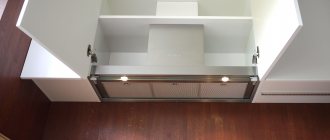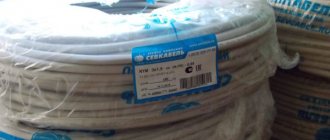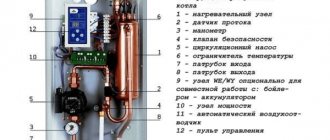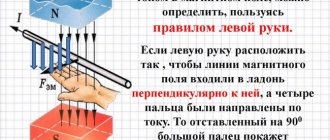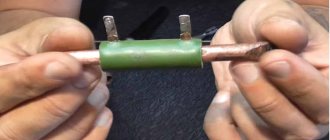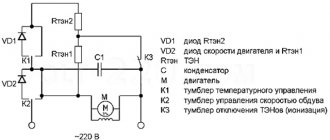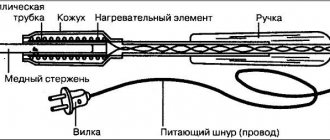Prologue
In the past, for all sorts of “thermal technologies” (of course, except for soldering and dismantling radio components), I used a small lighter with a nozzle. But a gas burner, in terms of producing a hot stream of air, has a number of disadvantages. With its help, it is impossible to smoothly regulate the temperature, the size of the torch depends on the amount of gas in the tank, an open flame can cause a fire, and finally, you need to buy gas in cans.
So, it was decided to make a small hairdryer from all sorts of rubbish that can be found in the bins of a DIYer. An additional incentive to produce this device was the price of a factory-made hair dryer, which starts at about $30.
I note that during the assembly and testing of the subject, I built another, still speculative, model of a hair dryer with higher power. So, if you need a more serious unit, stay tuned for new publications.
Main parts and materials
I've had this fan lying around idle for a while now. These 40mm fans used to be widely used in PC 486 and video cards.
This unit will require minimal modification. You will need to re-insert the wire into the attachment point.
I didn’t have a tube of a suitable diameter for the heater air duct, so I borrowed it from a ten-watt resistor type C-5-5. To free the tube from the insides, I sawed off one of its rolled edges with a file.
I do not recommend using ceramics or quartz glass for the heater air duct, as these materials can be destroyed if flux or wash accidentally gets on a heated surface. I’ll tell you a secret, I did my first experiments with a ceramic heater air duct, which collapsed at the first thermal shock. So, it is better to choose steel or, at worst, some non-ferrous metal.
In order not to bother with making a mica frame, I used a wire with a diameter of 1.2 mm from some kind of rheostat. I think a wire with a diameter of 0.5-1.5mm will do. If you choose a thinner wire, it will not be securely fixed in the housing, and if you choose a thicker one, you will have to increase the cross-section of the cable, which will make the latter too rigid.
Mica will be needed to make a gasket that insulates the coil from the heater tube. The fiberglass will serve as thermal insulation between the heater tube and the hair dryer body.
To make it more convenient to work with recalcitrant materials, you need to use “Rubber Glue”, “88H Glue” or “Moment” glue. Mica can be glued to fiberglass or even paper. The fiberglass can simply be glued and dried. As a result, the glue will burn out, but at the assembly stage it will provide indispensable help.
The heater spiral must be wound in such a way that it is inserted into the tube with a gap, which will subsequently have to be filled with a mica gasket. If you can find a tube of suitable diameter, you can insert the end of the wire into the tube and only then wind the spiral. I didn’t have such a tube, so I simply wound the wire around a metal rod, and then screwed the central wire inside the spiral. This technique is shown in the video>>>
I have used these wonderful products many times to solve completely atypical problems. In this case, electrical terminal blocks will transmit current from the cable to the spiral and fix the position of the spiral relative to the front edge of the tube (to prevent the spiral from shorting to the body).
To make the body of the hair dryer, we will use tin obtained from any non-corrugated tin can.
Often the cylindrical surface of the cans is hidden by a label. If you run your fingernail along the side of a jar in a store, you can easily recognize a jar with a smooth side wall.
From the cylinder of a five-gram syringe we will make a hair dryer handle.
Hairdryer from a soldering iron
Soldering gun diagram.
Before you make a soldering gun with your own hands, you should:
- think over a device for air supply;
- assemble a special heating element;
- equip the equipment with thermocouples;
- think over a system for monitoring the current temperature of the equipment.
When considering how to make a soldering iron from a regular soldering iron, you should take into account all the subtle points so as not to expose yourself to excessive risk.
The main criteria that a soldering iron-based thermal device must meet are:
- temperature adjustment;
- normal heater power;
- safe compressor.
It is recommended to install a supercharger for a DIY soldering station in accordance with current electrical safety regulations. Connecting the equipment in this way will ensure that there is no interference in the electrical network.
What do you need to create a hair dryer from a soldering iron?
When creating a hair dryer for soldering with your own hands, you should prepare:
- a regular old soldering iron running on AC power;
- a quartz tube to create a hair dryer air flow heating chamber;
- a halogen lamp for spotlights for heating the air and melting flux with a hairdryer;
- nichrome wire up to 0.7 millimeters thick;
- thermostat;
- soldering gun fan.
Schematic diagram of a soldering gun.
All equipment must be connected to specially prepared connectors at the soldering station, the pinout of which depends on the manufacturer of the soldering equipment.
https://youtu.be/3zE-HDdz2Xs
The process of assembling a hair dryer from a soldering iron
A homemade hair dryer for soldering microcircuits from an old soldering iron is assembled in several stages:
- Laying a homemade spiral of nichrome wire inside a quartz tube.
- Connecting the spiral to the power wire.
- Threading a thermocouple wire to regulate the temperature of the filament.
- Insulation of the device using a layer of tube wound on a quartz tube.
- Installing a tube in the handle of a soldering iron instead of a tip.
- Centering the tube by wrapping it with asbestos cord.
- Clamping the front tube outlet using a clamp.
- Threading a hose to supply air flow.
- Connecting a compressor that creates an air flow.
It is better to place the temperature regulator of the heating source on the body of the heat gun.
The operating principle of a hot air gun based on a soldering iron is as follows:
A small current is applied to the nichrome thread, causing it to become hot. The air coming from the compressor is collected in a special insulated chamber and heated under the action of a spiral and insulating foil. After this, the air leaves the heating chamber and goes directly to the printed circuit board.
Soldering gun - drawing for manufacturing.
Unfortunately, this method of making a thermal hair dryer has a lot of disadvantages.
The disadvantages of a hot air gun made from a conventional soldering iron include:
- difficulties with temperature calibration;
- The air flow force is adjusted by pinching the air duct;
- the inability to adjust the heating intensity in most conventional soldering irons;
- labor intensity of work;
- poor thermal insulation of the device.
In most cases, making a heat gun from a soldering iron is not justified. Remaking an inexpensive construction hot air gun is a much more efficient method of making a hot air gun for soldering micro components.
Drawings of a homemade soldering gun
This is an assembly drawing of a soldering gun. I was too lazy to draw isometric projections, but you can see the soldering gun from all sides by watching the video posted at the beginning of the article.
And this drawing shows the attachment point for the electrical terminal block. The M3 screw securing the terminal block is isolated from the tin body using a small piece of cambric (polyvinyl chloride tube) and an M4 fiberglass washer. An M3 fiberglass washer is placed between the screw heads and the nylon handle of the hair dryer. This washer prevents heat transfer from the electrical terminal block to the hair dryer handle through the M3 screw.
A drawing of the body of a miniature soldering gun in A4 format and 300dpi resolution is located under the thumbnail. If you print it on a printer and stick it on a tin from a tin can, then you can easily make the most complex part of this homemade product.
Small details
Let's look under the fan to see how the coil is connected to the cable. The design turned out to be very repairable. It is enough to unscrew just a few screws to replace the spiral, for example, in order to adjust the resistance of the spiral to the voltage of an existing power source.
I soldered the petals to the heater cable, but it was possible to roll the ends of the conductors into rings and tin them, just like we do when we change a collapsible power plug.
Most of the things I intend to do with a soldering iron require both hands free. Therefore, I made this stand for fixing the hair dryer on the table. A clamp with an open perimeter allows you to securely hold the hair dryer and, if necessary, easily remove it from the stand.
This is how the soldering gun turned out.
Making a hot air gun
A hairdryer with a fan and a nichrome spiral with a thickness of 0.4 mm or more are well suited for making an air-heated soldering iron yourself. Since we plan to assemble a homemade device of a compact size, a spiral with a diameter larger than 0.5 mm will not work. A larger cross section will require more current. First you need to select a power source, and then select the number of turns, since the resistance of the spiral and heating of the air will depend on this. In order to assemble a powerful hot air gun, a power source with a voltage of up to 36 V is sufficient.
Housing and heating system
An old soldering iron or a steel tube can be used as the body of the hot air gun, but since the operating temperature will be high, you need to wrap the tube with heat-resistant material or attach a handle holder. You can also use a car cigarette lighter as an air duct inside which the heating system will be placed.
At the next stage, it is necessary to wind a nichrome spiral with a small distance between the turns. A ceramic tube with a diameter of 4-5 mm can be used as an insulator on which the spiral is wound. The length of the spiral must be wound taking into account the resistance, which is calculated in the range from 70 to 90 Ohms.
Technical data
The hair dryer fan is powered from a 12 Volt DC source.
The heating element of the hair dryer is powered by an alternating current source of 0...12 Volts. With its help, you can change the temperature of the air flow, from room temperature to 600°C.
Mini-hair dryer parameters at temperature limits.
The diameter of the nichrome wire of the heating element spiral is 1.2 mm.
The heater supply voltage is 9 Volts.
The heater current is 11 Amperes.
Heater power - 100 Watt.
Air flow temperature - 600°C.
The time it takes for the hair dryer to reach the selected temperature mode is 1 minute.
I didn’t make a special power supply for my hair dryer, so I have universal sources of different power at my disposal.
If you do not have a suitable power source, then you can adjust the resistance of the spiral to one of the output voltages of the ATX computer power supply or make the simplest power supply from the ballast of a burnt-out CFL (Compact Fluorescent Lamp). For a detailed description of the modification of the power supply based on CFLs, see here>>>
In the picture, a circuit of a switching power supply for a miniature soldering gun, assembled on the basis of a CFL ballast. Additional elements are highlighted in red. Pulse transformer TV2 has two secondary windings. One of them powers the fan, and the other powers the heater coil. To adjust the temperature of the coil, switch S1 is used.
equipment requirements
Electrical circuit of a soldering gun.
The basic requirements for a hot air gun for soldering microcircuits with your own hands are:
- Compliance with soldering temperature conditions. Most soldering work is carried out within 190 – 250 degrees Celsius. The bottom bar is for lead-containing solders, and the top bar is for factory lead-free solders. The soldering hot air gun must produce an air flow of a strictly specified temperature in order to protect the microcircuits from overheating and failure.
- Stable air flow. If the air flow is uneven, working with soldering equipment becomes seriously difficult.
- Safety and ease of use. The heat gun should not overheat and pose a danger to the technician. Ideally, a powerful DIY soldering gun should be designed based on a transformer power supply.
The soldering equipment must contain exclusively safe elements. When making a homemade compressor power supply, special attention should be paid to the reliability of the design and its safety for others.
Experience shows that many craftsmen manage to make full-fledged working thermal tools from a hair dryer, a household hair dryer, or even an ordinary soldering iron.
About the heater temperature and the choice of material for its body
The operating temperature of the nichrome spiral should not exceed 1000°C. The temperature of a hot coil can be approximately determined by its color. The table shows temperatures in degrees Celsius.
| Metal | Temperature °C |
| Aluminum | 660 |
| Duralumin | 650 |
| Brass | 1000 |
| Copper | 1080 |
| Nickel | 1450 |
| Nichrome | 1550 |
| Steel | 1300 |
As you can see, copper, brass or steel are best suited for making the heater body. But, copper and brass quickly oxidize at high temperatures. Therefore, it is better to choose steel or nickel-plated steel.
If you have defective lithium-ion batteries at your disposal, you can make a tube from the body of one of the cans. The housings of the cans of any lithium-ion batteries and lithium-ion batteries are made of stainless steel.
The picture shows a disassembled laptop battery. The diameter of the can body is 16mm, length – 65mm. How to disassemble a laptop battery is described and shown here>>>
And this photo shows a disassembled “EN-EL1” battery from Nikon cameras. Can diameter 14mm, length – 48mm.
Attention!
The contents of lithium-ion battery cans and lithium-ion batteries are extremely toxic! Therefore, cans should be disassembled outdoors, and the extracted products should be sealed in a secure container and taken to a battery recycling point. Such items are usually available in large supermarkets and specialty stores.

